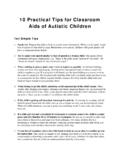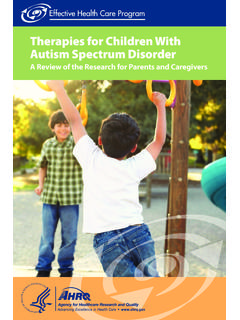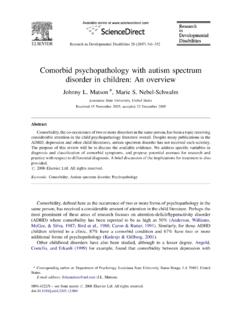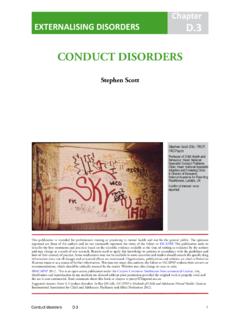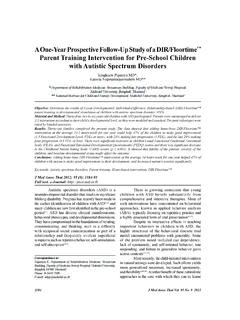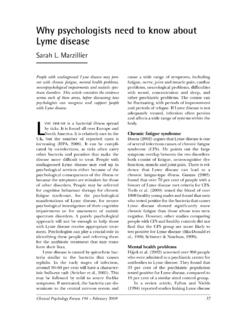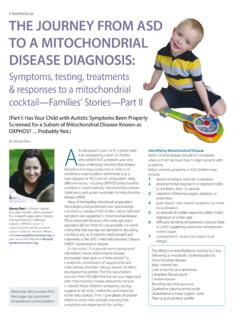Transcription of Coventry Grid ASD vs attachment problems Sept 2010 …
1 ! The Coventry asd vs attachment problems Grid Differences between autistic Spectrum Disorder (ASD) and attachment problems based upon clinical experience and observations (Modified Sept. 2010). ! ! Children with autistic Spectrum Disorder and attachment Disorder all present difficulty with flexible thinking and behaviour. Their behaviour can be demanding and ritualistic, with a strong element of control over other people and their environment. The different flavour' seems to be about personality style, a strongly cognitive approach to the world in autistic Spectrum Disorder, and a strongly emotional approach in attachment Disorder. The need for predictability in attachment Disorder suggests that the child is trying to have their emotional needs for security and identity met. In autistic Spectrum Disorder, the emphasis seems to be on trying to make the world fit' with the child's preference for order and routine.
2 !Symptoms problems seen Typical presentation in autistic Spectrum Disorder Typical presentation in attachment problems of ASD in both ASD &. AD. 1. Lack of Preference Repetitive questions related to own intense Preference for ritualised caring processes ( flexibility of for predictability interests bedtimes, meals). thought in daily life Repetitive questioning re changes in routines Repetitive questioning re changes in routines and and new experiences and new experiences behaviour Ritualised greetings Copes better with predictability in daily routines but usually enjoys change and celebrations Becomes anxious if routine is removed and may seek to impose usual routine ( wants same Looks forward to new experiences but may not bedtime routine when away on holidays) manage the emotions they provoke ( may not cope with excitement or disappointment). Inclined to try to repeat experiences and to interpret any repetition as routine ( asks/ Takes time to learn new routines demands repetition of following the same route to Routines tend to be imposed by adults in order school).
3 To contain the child's behaviour more easily Distressed when a routine or ritual cannot be completed ( when cannot follow the usual route because of road works). ! ! /!10. 2. !Symptoms problems seen Typical presentation in ASD Typical presentation in attachment problems of ASD in both ASD &. AD. Difficulties May limit foods eaten according to unusual Anxious about the provision of food and may with eating criteria such as texture, shape, colour, make, over-eat (or try to) if unlimited food is available situation, rather than what that food is ( will May be unable to eat when anxious eat chicken nuggets but no other chicken). May hoard food but not eat it May adjust eating because of literal understanding of healthy eating messages ( May be unable to eat much at a sitting sell-by dates, avoidance of fat). May crave' foods high in carbohydrate Restricted diet seems to be about maintaining sameness and the child is not easily encouraged Eating is transferable from situation to by people the child is attached to situation and the child can be persuaded by close adults Children tend to have a range of eating disorders Repetitive Echolalia May develop rituals for anxiety provoking use of language situations ( says same things in same Repetition of favoured' words which are chosen order when saying goodnight or leaving for for their sound or shape, rather than for their use school).
4 In communication or emotional content Children's repetitive seems to be like that of a Children's repetitiveness is out of synch with their younger child learning and playing with developmental stage language Unusual Often uses possessions as ornaments, especially May seek social approval/envy from others for relationship with making collections of objects, but does not seek possessions treasured social approval for the collection or for its care May not take extra care with possessions possessions Will often be able to say where most treasured which have been given an emotional possessions are and recognise if they are moved importance May be unable to dispose of old toys/papers/ May be destructive with toys, exploring them books even though they are not used and breaking them accidentally Shows a preference for old, familiar toys (or toys New and different toys are appreciated which are part of a series) rather than new and May lose things easily, even most treasured different toys possessions, and may be unable to accept any responsibility for the loss May deliberately destroy emotionally significant possessions when angry Heather Moran last modified Sept.
5 2010 Please email comments to or ! /!10. 3. Play is a clear problem in both groups of children, with a lack of imagination and an inclination towards repetitiveness evident in both autistic Spectrum Disorder and attachment Disorder. The difference seems to lie in what the way the children play: children with autistic Spectrum Disorder are inclined to choose toys which are related to their intense interests and to play with those toys by mimicking what they have seen on DVDs and television. They may also choose play that is cognitive and characterised by collecting and ordering information, such as train-spotting or reading bus timetables, and involves little emotional contact with other people. Children with attachment Disorder may lack play skills but their play interests tend to be more usual. !Symptoms problems seen Typical presentation in ASD Typical presentation in attachment problems of ASD in both ASD &.
6 AD. 2. Play Poor turn- May try to impose own rules on games May try to impose own rules on games so that taking and poor they win May see eventually losing a game as unfair if was losing winning earlier in the game May be angry or upset about losing games and blame others or the equipment for their Preference for playing alone or in parallel with failure (there is a sense of fragile self-esteem others in the style of reaction). Preference for playing with others who can watch them win Poor play Plays with toys as objects rather than Uses toys to engage the attention of other with toys personifying them children May spend all time organising toys and arranging May play games which include own in patterns ( ordering by size, colour) experience of traumatic life events and difficult relationships May play' with unusual things ( reading the telephone book, watching water run down the May have poor concentration on toys and be drain) for long periods from a young age able to play alone only for very brief periods Poor social Dislike and avoidance of others joining in play Relies upon adults to provide play play opportunities and/or to direct play Lacks interest in social play with parents/carers May prefer to play with adults (esp.)
7 Carers). rather than children Repetitive Lack of interest in developing a range of play Plays repetitively with adults much as a toddler play likes to play such as hide and seek, lap games Strong preference for the familiar and tendency to play alone for long periods Plays out past experiences and preferred endings repeatedly ( escaping from danger, saving siblings). Heather Moran last modified Sept. 2010 Please email comments to or ! /!10. 4. Poor Difficulty playing a variety of roles within games Difficulty ending role play games imaginative play Difficulty incorporating a range of toys into the May be able to take various roles but may same game ( using both Dr Who and show a strong preference for a kind of role Spiderman toys in a game) ( always the baby, always the angry father). Preference for toys which have a mechanical rather than emotional nature ( cars, trains, Lego) or which require logic and order ( reviewing and organising collections of objects) or examining objects ( watching spinning objects).
8 ! Heather Moran last modified Sept. 2010 Please email comments to or ! /!10. 5. There are key similarities in social interaction: children in both groups tend to have an egocentric style of relationship with other people and lack awareness of the subtle variations in social interaction which are necessary to develop successful relationships with a range of other people. !Symptoms problems seen Typical presentation in ASD Typical presentation in attachment problems of ASD in both ASD &. AD. 3. Poor Difficulties Interaction is usually one-sided and egocentric Seeks an emotionally expressive audience for social with social with little regard for the response of the audience interactions ( seeks to provoke strong interaction interaction reactions in audience such as anger, sympathy, Does not often manipulate others emotionally support, approval). More except through angry outbursts ( would rarely successful in ingratiate self with audience) May make persistent attempts to interact with interactions with adults or older children rather than with age May perform better in less emotional situations adults than peers peers Poor awareness of own role in interactions May initiate interactions with others which allow Own needs them frequently to play the same role in relation drive to self ( as the victim, as the bully).
9 Interactions Lacks awareness of risk and personal danger in interactions with adults Difficulty Lacks awareness of the social expectation that Aware of the social need to share but anxious sharing the child will share (because the child does not about sharing (especially food) and may refuse understand or need the social approval of others) or hoard or hide possessions and food to avoid sharing May not realise the needs of others waiting for their turn May take things which are important to others with awareness that this will be upsetting for the other person ! ! Heather Moran last modified Sept. 2010 Please email comments to or ! /!10. 6. !Symptoms problems seen Typical presentation in ASD Typical presentation in attachment problems of ASD in both ASD &. AD. 4. Mind Difficulty Rarely refers to the views of others May be manipulative (or overly compliant) and reading appreciating ingratiate self with adults/children others' views and thoughts Lack of Lacks awareness of other's views of self, Inclined to blame others for own mistakes appreciation of including lack of awareness of visibility' of own Draws attention away from own failures how others may difficulties ( may volunteer to perform gym towards own successes see them sequence even though child is very poor at gym).
10 May try to shape others' views of self by Does not appreciate the information parents biased/exaggerated reporting would like to hear about successes and enjoyment Limited use Rarely refers to the emotional states of self and others Hyper-vigilant with regard to particular of emotional emotions in others ( anger, distress, language approval) and often makes reference to these states Poor emotional vocabulary problems May not realise that cartoons, toys, animations Tendency to see self as more powerful and distinguishing and science fiction are not real able to overcome enemies, or as vulnerable between fact and powerless to offer any challenge May not realise that fantasy play is a temporary and fiction role May talk repeatedly of how to overcome captors/escape from imprisonment/kill enemies May be easily influenced by fantastic claims and even when these adversaries are obviously advertising bigger, stronger and more powerful than the Lies are often easily discovered and immature' child in style May not be able to judge whether a threat is realistic and act as if all threats, however minor or unrealistic.

